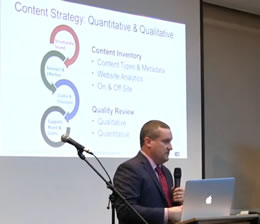
To succeed, content marketing needs to be customer-centric and look at the customer and customer experience from a holistic perspective. The customer experience is and will increasingly be the key contributor to the value of your business and best-in-class content marketing fits in a broader customer experience approach.
Integrated marketing thinkers, who know the customer is at the center, develop a fully eperience-driven content strategy. One of the is Ethology’s Mike Corak.
Mike was one of the keynote speakers at the Content Marketing Experience Conference Europe 2014, organized by i-SCOOP. Mike’s keynote (see SlideShare below) was a feast for more experienced digital (content) marketers and touched many great content marketing areas such as working with topics instead of keywords, qualitative and quantitative content strategy, and a fully experience-driven content strategy.
Working with clusters of meaning and topics instead of keywords always was crucial if you really want to focus on your “audience” first and on search next (both are connected anyway). With the ongoing changes in Google it is even more so. However, as Mike reminds us, technical aspects still matter too.
The essence of his message: improving user experience makes your customers and the search engines happy. I would add: creating the conditions for great end-to-end customer experiences is your key goal for the road ahead.
From Hummingbird to an integrated framework
Mike (member of the management team at ethology) delivered upon the promise of the integrated content marketing approach as you can read it in the interview below and further focused on – among others – how to conduct a content audit, taxonomy and working with a more developed content plan.
Hummingbird was an intro to that experience-driven and integrated concept, after which Mike showed a framework to integrate efforts and create an ecosystem for search and content success. Visitor Ashley Falkes summarized Mike’s keynote – and several other keynotes and presentations – well in his blog post “Content Marketing 2014 – What I learned at FusionMex“.
Time for that interiew.
Integrated marketing: roadblocks and solutions
Mike, you’re a 360° digital marketer, having used and combined all digital marketing tactics. An integrated approach has been heralded for years, taking into account the multi-channel behavior and increased ‘choice’ and ‘control’ of customers, among others. Why do you think it has taken and often still takes so long for businesses to integrate around the customer (experience and value) and brand’s proposition in a holistic way?
Mike Corak: Experienced marketers understand that there are labor and cost efficiencies in integrating tactics. Most also believe that 1+1 can also equal 3 in terms of increased conversions/revenue if tactics are working together to support a unified brand experience. While you’ll generally gain agreement on these topics, it’s perplexing that so many companies haven’t taken the necessary steps to implement an integrated ecosystem. I believe the gap between the vision and implementation still exists because, not only is it hard work, it frankly requires a cultural shift.
The roadblocks to integration we see most often are:
- Lack of true customer understanding: While companies are ready to purchase industry research, and perform certain levels of segmentation, digital data related to topical interest, vernacular, engagement and online behavior generally is still making its way into full brand planning.
- User experience is not prioritized high enough: We’re in an interesting time in digital. Unlike in the past, where we were focused on wrangling new mediums like social, most companies today are focused on refining efforts and improving performance. In some ways, because digital is so measurable, marketers focus on moving metrics and living in spreadsheets and Google Analytics. But one question remains: Once all companies have implemented according to best practice and reach an intermediate stage, what will differentiate digital programs in a crowded marketplace? The answer is superior user experience. This will be a primary focus in my presentation. And, yes, the theory applies to search, too.
- Decentralized content planning: Today, as we audit digital programs, we see a large disconnect around content planning. Beyond a centralized marketing calendar, it’s rare to see a centralized content plan that unites tactics and ensures proper promotion and engagement throughout each channel. It’s an easy enough concept. But it requires a centralized owner, who has a clear understanding of how to create and manage systems, which is not always so easy. Why? One of the main reasons is silo-based execution.
- Silos within internal teams and partner relationships: Most companies create integrated budgets for planning purposes, with projections per effort. What companies are still working through is unified tactical program planning and execution to guide and improve partner and internal team efforts. For example: with a content marketing program, content strategy, creative, search, social, email, media, local, and analytics all have to work together to be as effective as possible. However, what we typically find is that these groups are not structured to interact, making centralized planning beyond budgeting difficult to achieve. And, when speaking about cultural changes, teams must learn to unite around integrated efforts, identifying ways to assist related tactical executions to achieve common outcomes.
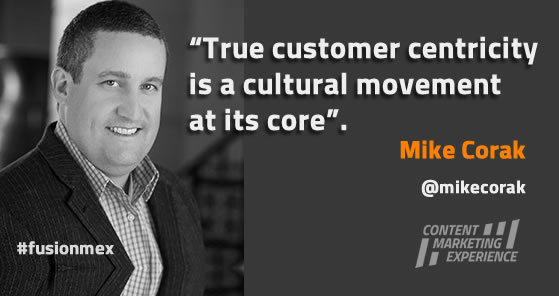
Leading brands are taking a content strategy first approach you say. Can you elaborate on the why, how and what of a content (marketing strategy)?
Mike Corak: Let’s first distinguish the difference between content strategy and content marketing. Content strategy is the art and science of planning, managing, and increasing the effectiveness of a brand’s content across all digital channels. It’s grounded in understanding the user’s needs and business’ objectives, taking into account how those components affect the entire ecosystem.
Content marketing is a subset of content strategy, in my opinion. It concentrates on the practice of using content to draw prospects into a brand’s conversion process, just as a paid advertisement would. In essence, content marketing is just marketing.
The demand for more content has grown exponentially over the last few years, and many companies are playing from behind, still building the assets and systems necessary to meet demand. What we see missing are the systems to grow effective, results-driven content proactively. A content marketing plan that is fueled by the knowledge of what the content strategy process uncovers will result in different content topic priorities, production priorities, and larger gains in meaningful results. For example, making a core content page more shareable may result in increased social activity, even more than a blog post. Or, understanding where a brand lacks overall content coverage against its desired taxonomy may inform what tomorrow’s blog post should be about.
That said, brands that take the steps to (1) understand what their target audiences want from them, (2) develop their desired topical taxonomy authentically with the user top of mind, (3) observe how others are successfully meeting that demand, (4) audit their content across all channels against these variables and business objective performance, (5) create a gap analysis detailing where they are v. where they want to be, (6) examine their current operational abilities to execute against the opportunity, and (7) then create a plan with their unique opportunities and future in mind, will beat those who are simply concentrating on what their next social post should be about. Or, in other words, those who develop a true content strategy will win out.
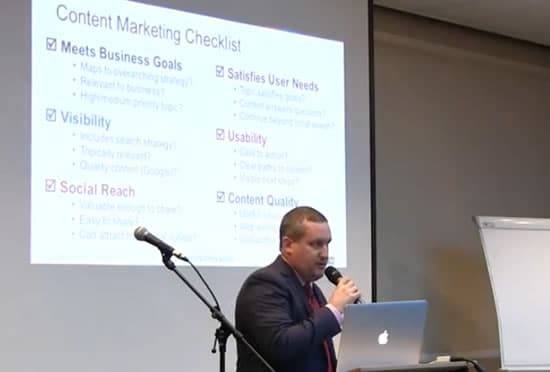
Email marketing, social and content: towards completely integrated CRM
You have worked with Econsultancy at several occasions. I found a report and SlideShare presentation from a webinar where you and Gary Vaynerchuck discussed social media, micro-content and visual storytelling (Top 8 Social Media Trends for 2014). Gary said, I quote, “learn to natively storytell on each platform”. What are your views on storytelling and the whole concept of native?
Mike Corak: You’ve done your homework! Impressive. I think Gary’s message that each platform represents a unique community with varying behaviors and content needs is an important concept to understand. One can’t simply take the same post and blast it through Facebook, Twitter, Google+, Instagram, etc. and expect to please a fan base.
More so, you should plan your content needs based on user personas, business needs and platform attributes. This helps you understand what is more likely to perform in each platform, then build the activity into your plans from there. Being native and storytelling in this sense means becoming a true community member in each platform with authentic communication.
In the same presentation you mention a full content strategy integration and I’m glad – as I read in another post – that you also put an integrated view on lifecycle marketing and email marketing in it. It seems email marketing is seldom mentioned when we talk about content marketing. Why is that, you think? And what role do you see email marketing play today?
Mike Corak: In reference to my prior silo point, email is often left out of content plans. In my experience it’s forgotten, usually sitting in a removed department or connected with direct efforts apart from the day-to-day marketing conversation. It’s typically running on its own, with automated processes and uncared-for content. Further, most content marketing plans are built to target new interest and drive new sales, rather than nurture existing customers. That’s really a shame, because, as marketers, email and SMS are one of the few channels where users have voluntarily subscribed to receive communication, and where personalization and customization measurably improve user experience, company loyalty, and the bottom line simultaneously. It’s the ideal opportunity for true relationship building through content.
Email is powerful – it’s the most ROI-efficient digital marketing channel because it’s cost effective. It’s opt-in, so, in theory, the content is desired, and you know exactly whom you’re talking to, what they want, and when they want it. It’s your best retention medium as well, and is a great closer. Segmented personas are one thing, however, direct content can be delivered one-to-one to promote new business and grow customer relationships—a content marketer’s dream.
For this reason, email can also be used to inform other efforts. True audience segmentation leans heavily on current customer data, and few mediums contain the type of data content marketers crave related to performance and interest-based audience segmentation. Additionally, email can also be used for content and message testing.
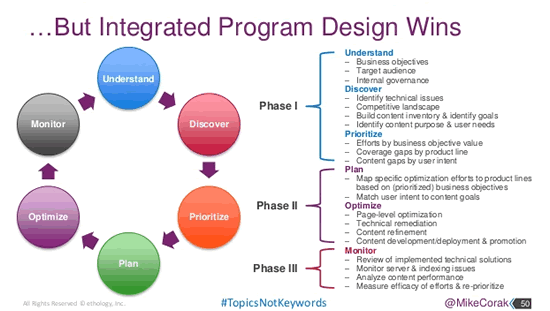
You’ve been in the industry for a while and so you don’t overlook less “sexy” but still very relevant channels. I wonder what your take on the role of print is.
Mike Corak: The vast majority of my clients are slowly moving budget out of print. As many studies show, investment to return makes the channel inefficient in comparison to others. I do however think the underlying blanket statement that print doesn’t work is a bit off. If there’s a publication with strong readership matching your demographics that can drive interest to conversion, why not invest? The strategy, however, must be to match investment to potential return.
With print readership generally decreasing, and overall consumer behavior evolving, priorities must change. For the record, I believe strongly in offline’s ability to start the conversation and create interest. In the U.S., less than 30% of our media exposure time is spent online, making strong offline activities mandatory. I see great success when clients tie their efforts across channels, understanding every channel’s strength and role, rather than pitting tactics against each other with a shortsighted ROI lens.
Many years ago, when social media popped up, I launched a blog on the integration of social and email. In the beginning, some ESP were furious (no kidding). However, now they all offer social features. One of them is ExactTarget. Last year you conducted a webcast with ExactTarget’s Kyle Lacy on the topic “E-mail + Social = Profitable Client Retention”. Can you share some takeaways?
Mike Corak: That’s unfortunate as you were definitely on to something! Completely integrated CRM is the target on the horizon. I think the industry has realized that we’re talking to the same people across channels and that we can be more effective if we understand how people want to engage, and where and when they want to do so, on their terms. Sounds simple, but it’s still difficult for some to see customers as actual people, as opposed to a row on an email list and/or a Facebook Like.
On that note, for all the talk of total marketing solutions and platforms, the truth is few companies fully integrate their direct mediums. With silos, technology integration gaps, skill set deficiencies, etc., there are many impediments. But again, the opportunity to build strong relationships through customization and building audience relationships should be the key motivator.
While we close these implementation gaps, here are the main places where integration can help today:
- Cross-membership promotion, email and social: The trick here is to make sure you thoroughly explain program differences and value, using each medium for the characteristics and strengths it has, and deliver upon those program promises ongoing. Email signup can be promoted through social, coded right into a tab or app. Social signup from email, even segmented based on social network membership, can be an effective way to grow an audience.
- Email content sharing via social activation: Email content can be as valuable as any other medium. Allow your email content to be shared in individual modules v. simply having the social account links in the footer. Products, blog content, etc., all can grow readership if allowed to travel.
- Use email and social performance to inform future content efforts: Seeing what works, by audience, is a powerful benefit of these channels that can be applied to help their performance as well as the performance of other channels and the brand as a whole.
Speaking of ExactTarget, I recommend checking out Jeff Rohrs’ book, “Audience: Marketing in the age of subscribes, fans & followers.” It puts a nice wrapper on the idea of full audience relationship building, the “audience imperative.” (editor’s note: marketing automation vendors ExactTarget and Pardot have been acquired by Salesforce.com).
Less than a week before the Content Marketing Conference you spoke at Integrated Marketing Week. I mentioned it before: integrated marketing, the customer experience,… One of the challenges regarding an integrated marketing approach is planning, a topic you will cover. Can you share some thoughts on that?
Mike Corak: Yes, a great conference! Planning is a topic I often speak about, and a core discipline at ethology. As I mentioned before, tactic-based budgetary planning, with tactic-generated projections, is where most companies are at today. The point on the horizon that we like to work toward is ecosystem planning, balancing user and business needs with operational considerations and tactical integration. There are a few Slideshare presentations I’ve published on the topic that run through a process I like to employ.
The fundamental steps to run through are:
- Business Goals: Ensure they are outlined, understood, and measurable, tying digital metrics to offline business performance. This last part is essential, and, in most cases, your analytics platform needs some customization to make your metrics analysis fully usable.
- Conduct Audits and Gather Inputs: Each period, you should be learning more about your audience and customers, then adjusting efforts system-wide. Further, getting in the habit of auditing tactical programs and setting growth roadmaps against KPIs is critical. Don’t forget to also audit your user experience across channels. Do you have a user experience roadmap? This includes content and visual components and should be thought about as a constant evolution v. one-time fix. Watching competitive efforts at least quarterly across tactics is also critical. Much change occurs, especially on the content front these days. And don’t forget to audit your staffing and partner delivery ecosystem to gain the most efficiency possible – this also includes tools and technology.
- Strategy: Finding opportunities to improve is critical in the process. Audits will show you tactically how to roadmap. Ideation based on user behavior and desire is also key to growth. Opportunities should also cover ecosystem adjustments and rightsizing staffing and partner coverage as needed. Once all opportunities are outlined, they should be prioritized and fleshed out for planning and budgeting.
- Budgeting: Only now should you be creating your budget, based on your prioritized opportunities. Knowing what will move the needle most significantly first allows companies to apply funds where they are most needed. This may not always chase the new shiny object, but it will allow for goal achievement and increased funds down the road.
- Planning: Once all inputs are known, opportunities are weighted, and budgets are in-order, tactical plans should be created, with roles and responsibilities clearly outlined. Don’t forget to outline processes here to promote integration around natural tactical groupings and programs.
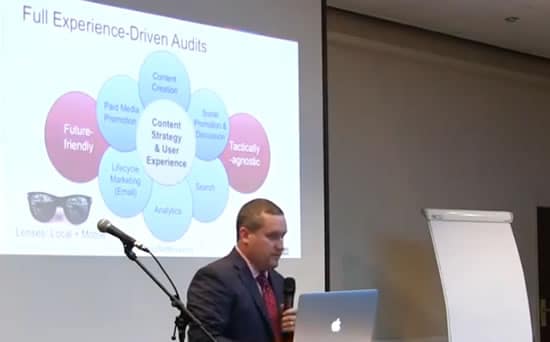
I read a quote from you that one of our other keynote speakers, Jay Baer, put in a SlideShare presentation, which I loved. I quote: “Most companies that have a social monitoring tool are using it for brand listening and sentiment analysis. It’s very rare to see listening around the broader topics that impact the company and its customers“. Way to go. Creating content without an integrated Voice of the Customer plan or truly listening is a sign of the company-centric attitude many still have. What does it take to become truly customer-centric?
Mike Corak: In my opinion, true customer centricity is a cultural movement at its core. Polling, listening, recording, and understanding the voice of the customer is critical for content marketing. But the learning opportunity is larger. If you’re able to truly understand your customer, you can anticipate future needs and proactively meet them in the overall user experience, at every touch-point. Attributes of truly customer-centric companies include a deep understanding of customers on and offline, through data and interaction. Typically these companies have a focus on customer service, and the positive result is usually seen in sentiment analysis online. Nordstrom is my absolute favorite, and you can feel their focus in everything they do online.
Bringing this back to content and listening, it’s important to understand and prioritize the voice of the customer to inform content strategy and content marketing. Per my comment, when we dig into client listening efforts, we see robust examination of sentiment-related activity. Important for many reasons, especially on the reputation management side, this interest is typically prioritized highly.
What’s usually missing is topical demand and understanding. In our agency, the process moves clients through creating a desired taxonomy, identifying non-branded topics that the brand can authentically engage and provide useful content, thought leadership, and branding around. From here we do topically based keyword research and deep social listening to learn about the taxonomy’s nuances. This isn’t just meant for real-time content marketing (my favorite thought leader here being Taulbee Jackson at Raidious). It’s meant to drive and inform true topic-level understanding to impact the performance of user experience and content efforts on an enterprise level.
Mike Corak at the Content Marketing Conference 2014: who and what
Your presentation at the Content Marketing Conference Europe tackled the opportunity for brands to align their content and search efforts accordingly. What do Google and topics, rather than keywords, have to do with that?
Mike Corak: Google is becoming more semantic-based, rather than keyword-based. The intent of this shift is to understand the context of a query and serve content that best matches user needs, instead of listing pages that best target specific keywords. This is a game changer for search and content practitioners alike, because it moves us to a point where the best, most relevant content should win in terms of visibility and traffic, which puts the emphasis on quality v. search factor manipulation.
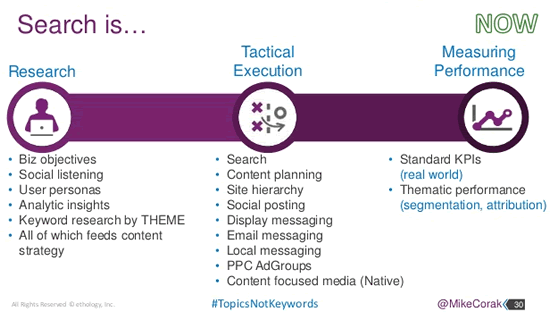
The irony is this is how we should have been attacking search all along, and those who did are now being rewarded. Google has just finally been able to technically catch up. The good news is that, as technical adherence to search best practice is becoming easier than ever before, if we as marketers can concentrate our efforts on creating the best user experience possible, within the taxonomy our brands can authentically own, and promote that content properly in an integrated fashion, we’ll be rewarded by our users and Google alike.
As is becoming a tradition, I’d love to wrap up with the question to complete the sentences below:
- What people should know about Mike Corak is…that he’s plugging away, building real strategies with his team for real clients, just like those in the audience. Strategy practitioner first; Speaker and thought leader second.
- Content marketing…. is just marketing. Don’t see it as a shiny new object, think about it as a tactic unifier that deserves the same kind of attention as your paid channels.
- The best content is…content that your users want and use.
- When in Antwerp, Mike Corak considers to buy…anything that will keep my wife out of the diamond stores – any suggestions on all-day tours?
- Custom(er) publishing…I have had a change of heart here over the last few years. I’m not sure everyone is a publisher or should be. The industry, myself included, used this lingo to inspire content-related activities, but I think we’re beyond that now. Creating and managing company content and publishing content are likely two different activities with varying expectations and needs.
- Throughout his career, Mike Corak has been inspired…by hard and smart work, team accomplishment, and game-changing results achievement. I love market disruption as much as the next, but respect methodical improvement and planned growth even more.
- To people who just start with content marketing, Mike Corak says…take a step back and think bigger. Content Marketing is the output of a larger, more comprehensive effort. Prioritize building your system, then concentrate on the output. Your results will show the difference and make the time you spent upfront worthwhile.
- Relationships are created with…integrity, transparency, patience, and mutual trust over time.
- Gap analysis…shows where you are today v. where you need to be, and is the crux of creating an informed plan.
- Micro-content…is more important than ever and worth the time spent to get it right. Depending on the state of your micro content, you may see more movement here in results.
- Cultural shifts that break down silos…must be planned, believed, lived and breathed, then held to with extreme scrutiny. They are also some of the most rewarding achievements an entity can experience.
- An ethologist…is an integrationist and a consumerist. Ethologists work on client teams first, tactically, selflessly, moving the needle on business goals, by any means necessary. Ethologists also mine every shred of data to better understand the end user, and improve execution thereafter.
- As a former Senior Strategic Planner, Mike Corak…is still a strategic planner! Once bitten, you can never go back—it’s an addiction.
- What Mike Corak would love all marketers to understand…is that innovation and effort optimization, are equal in importance, but they’re only achieved through daily, ongoing focus.
- Within 5 years from now…I’m hopeful that we as an industry will solve for the foundational, organizational and tactical opportunities we see in the marketplace today (tactical excellence, program integration, ecosystem development, user experience and customer informed activities), and be able to differentiate on the creative campaign layers that can live above it all.

